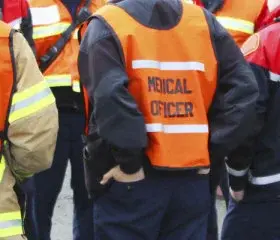/working-outdoors-banner-1600x399.jpg?width=300&name=working-outdoors-banner-1600x399.jpg)
ESSENTIAL SAFETY MEASURES FOR WORKING OUTDOORS
Australia presents a diverse range of risks to outdoor workers. From extreme weather through to dangerous spiders and snakes, you need to have plans in place to protect any employees outside.
These plans are particularly important during Australia’s blistering summers, when temperatures soar and the risks from UV radiation climb. Below we discuss protection from the weather, provision of facilities and protection from UV radiation.
Our objective is to ensure that outdoor workers are adequately protected from all adverse outdoor conditions, not least of which the weather. Hazards related to poisonous or toxic flora and fauna including insects, spiders, snakes and poisonous or toxic plants are also considered.
Let’s break this down into the major issues to be addressed.
In work locations where personnel may be exposed to low temperatures, high winds, and wet conditions, first aiders should be trained in recognising the symptoms of hypothermia and administering the relevant first aid.
The provision of first aid for hypothermia must include:
- Prevention of further heat loss (clothing, blankets, etc)
- Provision of heat (indoors, warm drinks, heat packs, etc)
- Evacuation (if required, to a hospital)
Activities carried out in the sun must be assessed to determine whether:
- The task can be carried out indoors or in the shade; or if this is not practicable, direct exposure to the sun can be minimised.
- Outdoor workers must be provided with equipment to protect them from UV radiation, such as broad-brim hats, sunglasses, clothing with the appropriate UPF (UV Protection factor), etc. This should also apply to Personal Protective Equipment (PPE) and must include items such as UVR-rated hard hats, etc.
- The use of long-sleeved shirts and long pants should be promoted and clothes provided to personnel should be light and loose, so as to allow ‘breathing’ and reducing the potential for thermal stress.
- Arrangements should also be established to ensure the consistent use of sun screen by all personnel exposed to UV radiation.
- Personnel who are required to work in the sun must be given information to increase their awareness of the importance of using the protective measures provided.
Managers must take steps to prevent the effect of heat on workers required to work outdoors in hot weather. This should cover heat exhaustion, heat cramps, heat stroke, etc.
Measures can include the provision of shade (where possible), the provision of loose clothing, and ensuring the availability of salt-replacement fluids.
Workers should be provided with awareness training and instruction on the risk associated with lightning strikes. This must include steps to be taken in the event of being outdoors during a thunder storm. These steps normally include, but are not limited to the following:
- immediately seek the shelter of a building or an enclosed vehicle;
- never shelter under trees;
- if in a boat, immediately head for shore;
- don’t touch any metal objects; and
- if caught in the open, crouch down with your feet together – do not lie down.
In areas where personnel may be exposed to natural hazards, arrangements must be in place to manage the associated risk, including:
- To provide personnel with information on the risks and to ensure they are able to identify such hazards;
- To ensure good housekeeping and workplace hygiene and to have in place arrangements for the regular disposal of rubbish;
- To provide personnel with insect repellent as required;
- Where appropriate, to ensure that work areas are assessed for infestation (e.g. wasps nests and bee hives) and that any such sources are removed.
- Where required, first aid provisions should include specialised first aid kit modules (eg for snake, spider and insect bites). This must include the provisions of kits to personnel working in remote locations.
Workers required to work outdoors (particularly in the hot sun) for extended periods should undergo periodic health assessments.
The assessment takes into consideration the risk factors of personnel who may be exposed to the heat. These risk factors should include:
- Specific conditions relevant to these personnel (e.g. mature aged persons, pregnant women, persons who are obese or in poor physical condition, etc);
- Any recent illnesses suffered by personnel involved;
- Any other considerations specifically relevant.
Where appropriate, such workers should be given the opportunity to acclimatise to these conditions over a period of time.
Outdoor work brings unique risks—your system should reflect that.
We help you build a WHS Management System tailored to your environment, your teams, and the realities of working outdoors.Download Your Free Checklist PDF
Get instant access to our expert-designed checklist to help you. Simply fill out the form below to download your copy.SIMILAR READINGS

2 min read
2 min read
Don’t leave your employees out in the cold – manage their...

3.5 min read
3.5 min read
Learn how to effectively manage the fatigue of your workers...
Read More
3 min read
3 min read
Guidelines to ensure your staff are ready in an emergency...

2 min read
2 min read
Meet your obligations for monitoring and reducing workplace...
Read More